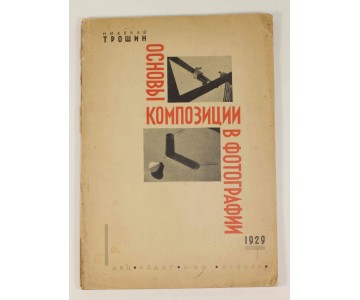Troshin N. Fundamentals of composition in photography. Experience in determining the basics of building a photographic image.
Nikolai Troshin (1897-1990). The artist was born in Tula. His professional studies began at the Penza Art School, which was later transformed into a department of VKhUTEMAS. In 1918, twenty-five works of Troshin were first exhibited at the Exhibition of Paintings, Sculpture and the Art Industry in Ryazan (among the participants were Baksheev, Gerasimov, Vasnetsov, Pasternak and other masters). He continued his art education in Moscow, in the capital VKhUTEMAS, in the workshop of Ilya Mashkov. He began to make posters for the Transreklama enterprise, together with his wife he designed a series of children's books - "How Cotton Became Calico", "Bakery No. 3", "From Rubber to Galoshes" and others. He was attracted to photography, he wrote a lot for the magazine "Soviet Photo", even published a book "Fundamentals of composition in Photography" (1929). From 1930 to the beginning of the Patriotic War, he designed more than 40 issues of the magazine "USSR at the Construction Site", in 1937 the publication was awarded the Grand Prix at the World Exhibition in Paris. In the 30s, he was the author of projects and design of art exhibitions "Five-year Plan in Four Years", "Victory of the First Five-year Plan", the Press Department in the Soviet pavilion of the Paris exhibition, the Ryazan Hall at the VSHV. He participated in the thematic design of the central squares of the capital: "Bluming", "Metro", "MTS", "Volga-canal" and "Belomorkanal". In 1936, Troshin's first solo exhibition was held. In 1937, together with D. Moore and S. Senkin, he designed the Manezh Square on the theme "Abundance". In 1940, he worked for the publishing house "Art" on the album "Red Army". During the war, he made defense posters, in 1942 he took part in the exhibition "Moscow Artists During the War". A long-standing interest in photography has affected again: the artist received a patent for the invention of a method of chemical coloring of photographs. In the second half of the 50s, he designed the departments of the exhibitions "Electronics and Communications" at VDNH, "Socialist Moscow" at the Museum of History and Reconstruction of Moscow, "Higher Education in the USSR" in New York. Since 1960, he left working on large projects and focused on easel painting.
The copy is in good condition, in publishing covers with an avant-garde design.

 +
+ +
+ +
+ +
+ +
+ +
+ +
+ +
+